| |
 |
|
|
|
| |
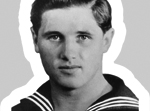 |
Petty Officer Telegraphist
Helmut Baltz
Radio Operator, 9. Division
* 24.1.1917 in Bad Schmiedeberg (Saxony) - † 27.5.1941
|
 |
|
|


Germany (1917)
Source:
Ronny Hoffschulze / Brunsbüttel
Destroyer Georg Thiele
Layed down: |
24.10.1934 |
Launch: |
18.08.1935 |
Commission: |
27.02.1937 |
End: |
13.04.1940
(grounded) |
Displacement: |
2.200 ts |
Size: |
119 m x 11 m |
Crew: |
325 men |
|
After the war began, the Georg Thiele initially guarded the Baltic Sea approaches, then served as an outpost in the North Sea. An engine failure at the end of 1939 forced repairs and conversion work.
In April 1940, shortly after the shipyard work was completed, the destroyer took part in the occupation of Norway. During the ensuing Battle of Narvik, after it had used up its ammunition, it was grounded and blown up.

|
Helmut Baltz was born on January 24, 1917 in Bad Schmiedeberg, a small town in Saxony, located in the Düben Heath between the Mulde and Elbe rivers. He grew up in a family of butchers. After school, the eighteen-year-old decided, like his younger brother later, to join the navy and volunteered. In 1935, he was started into basic training and then trained as a radio operator. His first on-board command took him to the old torpedo boat G7, a veteran of the Imperial Navy and as such a participant in the Battle of Dogger Bank and the Battle of Jutland. This boat was transferred to the new Reichsmarine after the war and fulfilled its role there as a training boat. In 1937, the crew of G7 formed the core of the new destroyer Georg Thiele. This new ship was the second destroyer in the 1934 destroyer class, the first german post-war destroyers ever. Helmut Baltz joined the new ship at the Deutsche Werke in Kiel. He was one of the radio operators on board. He soon developed a close friendship with his radio operator colleague Hinrich Gatermann, far beyond the service. Helmut Baltz was nicknamed "Homer" on board. When the war broke out, he was already in his third year on the Georg Thiele and had meanwhile been promoted to leading telegraphist. At that time, his destroyer was part of the 1st Destroyer Flotilla under the command of the commanding Admiral of the torpedo boats, Rear Admiral Lütjens. In the first days of the war, the ship took part in several mining operations to lay the so-called West Wall barrier.
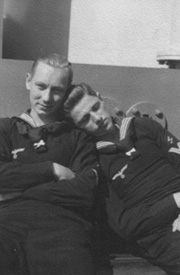 The Georg Thiele set sail on April 7, 1940 as part of Warship Group 1 for Operation "Weserübung". The group consisted of ten destroyers and its goal was to capture the Norwegian port and mining town of Narvik. The entire 3rd Mountain Division of Lieutenant General Dietl was on board. 200 men on each destroyer, including weapons and equipment. The crossing was accompanied by a severe storm. With wind force 6, the sea rolled in from astern and caused the destroyers to yaw violently. On the Georg Thiele, the failure of the port main cooling water pump forced a temporary reduction in speed. However, the damage was repaired to a certain extent using on-board resources. On the evening of April 8, the group finally reached the Norwegian coast, where the sea finally calmed down.
The Georg Thiele set sail on April 7, 1940 as part of Warship Group 1 for Operation "Weserübung". The group consisted of ten destroyers and its goal was to capture the Norwegian port and mining town of Narvik. The entire 3rd Mountain Division of Lieutenant General Dietl was on board. 200 men on each destroyer, including weapons and equipment. The crossing was accompanied by a severe storm. With wind force 6, the sea rolled in from astern and caused the destroyers to yaw violently. On the Georg Thiele, the failure of the port main cooling water pump forced a temporary reduction in speed. However, the damage was repaired to a certain extent using on-board resources. On the evening of April 8, the group finally reached the Norwegian coast, where the sea finally calmed down.
The capture of Narvik the next day went relatively smoothly. Only two Norwegian coastal armored ships defended themselves against the invaders and were subsequently sunk. The Georg Thiele then landed her mountain troops on the ore pier of Narvik harbor. On the morning of the following day, April 10, the British 2nd Destroyer Flotilla, consisting of five H-class destroyers, managed to launch a surprise fire attack on the completely unprepared German destroyers in Narvik harbor. The German command boat Wilhelm Heidekamp, with Commodore Bonte and his staff on board, was their first victim. Shortly afterwards, the Anton Schmitt also sank. But not all of the German destroyers were in Narvik harbor. The other destroyers rushed out of the fjord arms to join the battle. The destroyers Georg Thiele and Bernd von Arnim relocated the fjord entrance to block the retreating British from returning. They combined their fire on the British command ship HMS Hardy, which alighted on a fjord, burning. Another destroyer sank in the middle of the fjord. The other British destroyers escaped damaged in a snowstorm, although the Georg Thiele managed to land a torpedo hit. But she too was badly hit. Without sufficient fuel and ammunition, the destroyers' fate was sealed in Narvik. An attempt to break out also failed due to the heavy British naval forces securing the fjord exit.
|
|
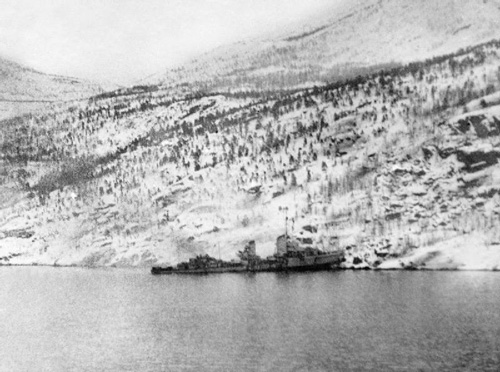 The grounded Georg Thiele |
|
|
On 13 April 1940 the Royal Navy launched its next attack, this time with nine destroyers and the support of the battleship HMS Warspite. One by one the German destroyers were pushed into the outermost fjords and destroyed. This included the Georg Thiele. With its last torpedo it scored a heavy hit on the pursuing destroyer HMS Eskimo, tearing off its entire forecastle. After the Georg Thiele had used up its last ammunition, it found itself in a hopeless situation. The commander decided to abandon ship. In order to save the crew he drove at full speed onto the embankment. At the same time the ship was scuttled. While the crew left the ship, the shelling continued. The Georg Thiele was now ablaze all over the boat. 27 crew members died. The survivors, including Helmut Baltz, escaped over the mountainside to the Rombak railway station and followed the Erzbahn railway line into the Björnefell, where they joined Lieutenant General Dietl's mountain troops. During the night, the wreck of the Georg Thiele broke in two; while the stern slid into the depths of the fjord, the bow, half twisted and sticking up, got caught in a rock. To this day, now heavily rusted and slipping slightly, it lies in this position as a memorial to the battle. All eight remaining German destroyers were destroyed in the battle. However, the fight continued for the approximately 2,500 crew members. They joined the mountain troops. Cut off from any supplies, they were left to fend for themselves.
On April 14 1940, a 24,500-strong Allied expeditionary force landed near Harstadt, north of Narvik. In addition to British forces, French and exiled Polish units also fought in the corps. Lieutenant General Dietl, who was significantly outnumbered with around 4,500 men, was ordered to hold Narvik. On April 24, Norwegian troops began attacking the German troops. Some of them had already entrenched themselves in the mountains. The completely destroyed city area of Narvik was evacuated four days later after tough fighting and the retreat into the mountainous hinterland of Narvik began. There, the German troops managed to at least hold the ore railway against the Allied troops, who were inexperienced in alpine terrain. With the beginning of the Wehrmacht's western campaign on May 10, 1940, the situation in Narvik also changed. On May 24, the Allied forces were withdrawn to reinforce the troops in France. At this point, it was only a matter of time before the German troops surrendered.
|
|
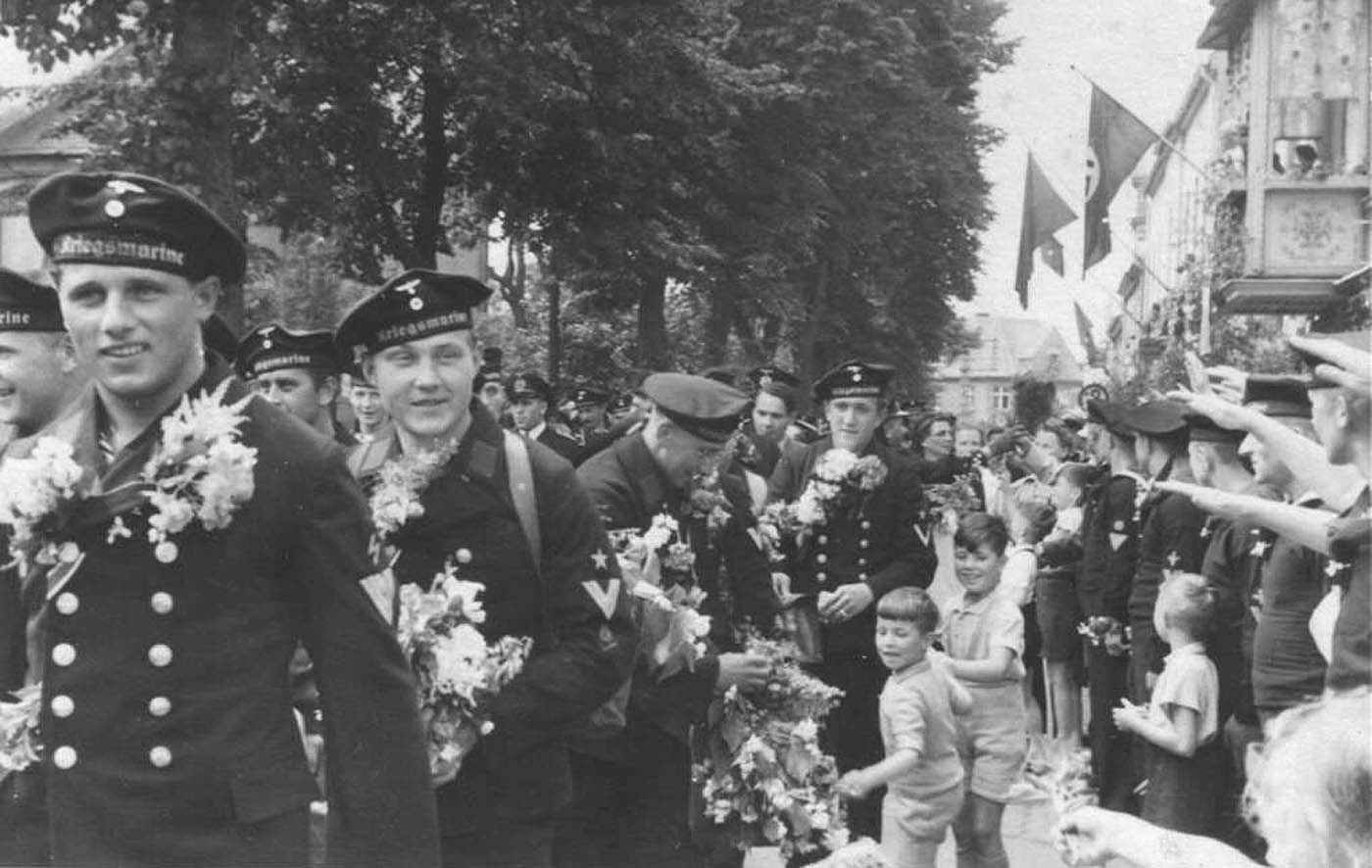 Welcoming the crew of the Georg Thiele returning from Norway Helmut Baltz (left in the picture) was a leading telegraphist at the time and had just been awarded the Iron Cross 2nd Class |
|
|
|
|
|
* The new command would not have allowed an early vacation.
|
Helmut Baltz, who had taken part in these battles, was awarded the Iron Cross 2nd Class. A newspaper article states: "Leading telegraphist Helmut Baltz was awarded the
Iron Cross 2nd Class. He earned this award through his outstanding commitment during the battles for Narvik. We congratulate him most sincerely." He was also awarded the Narvik Shield and the Destroyer Badge for his service in Norway. Now, after Narvik had been recaptured and connections to the outside world had been restored, Helmut Baltz returned to Germany, where the returning soldiers were welcomed with great enthusiasm. Helmut Baltz then attended a petty officer course and was promoted to petty officer telegraphist after passing the course. His subsequent transfer to the Bismarck was based on an unusual coincidence. Another radio operator was actually scheduled to take over the Bismarck, but he got hold of the command before his superior and quickly replaced his name with that of Helmut Baltz because he himself was about to get married.* The matter was later discovered, however, after Helmut Baltz had already taken up the new command on the Bismarck. Instead of a transfer, the radio operator in question was transferred as a punishment and Helmut Baltz remained on the Bismarck, with which he set sail a short time later for Operation Rheinübung.
Helmut Baltz was killed on May 27, 1941, when the Bismarck sank. He was 24 years old. His radio operator friend Hinrich Gatermann from the Georg Thiele only found out about his friend's death years later. Although he had known about the posting, he was never certain about his friend's death until 1997, when he happened to meet a new neighbor from Bad Schmiedeberg, Helmut Baltz's birthplace. When he saw the obituary, tears came to his eyes; now he had finally learned about his friend's death.
Photo gallery – Helmut Baltz on the Bismarck
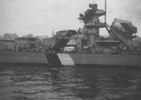
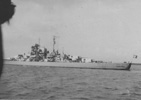
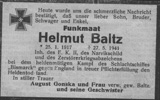
Click on the pictures to enlarge.
|
|
|